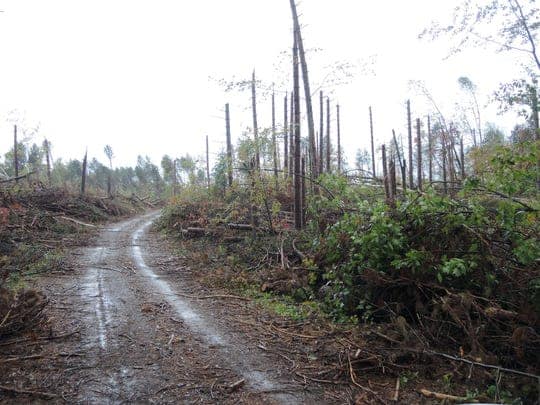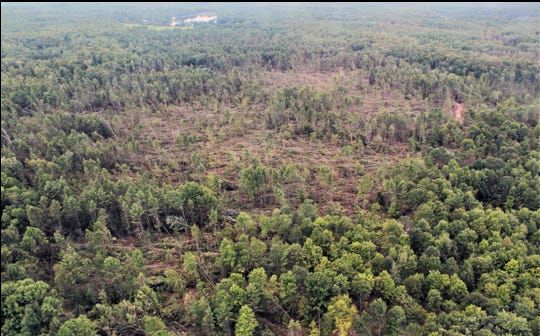
Larry Parnass wrote this story about a July windstorm in Wisconsin- worth reading in its entirety- also excellent photos. For westerners, it’s interesting that even though they have a healthy forest products industry, they too suffer from needing to remove the kind of woody material for which there is no market, or the prices are so low that removal can’t pay for itself. Too bad they can’t do chip and ship, as we previously discussed for Northern Arizona. Also the need to clear roads and keep people safe from falling trees seems like some of our insect-induced disturbances. We don’t hear much about the forests in the upper Midwest and I, for one, would like to hear more.
Their devastation remains topic No. 1 across Oconto and Langlade counties. As repairs and cleanups continue three months later, officials who manage federal, state and county forests still labor to grasp the extent of damage. The U.S. Forest Service estimates that at least 63,000 acres of the Chequamegon-Nicolet National Forest were affected — a land area larger than the city of Milwaukee.
That impact doesn’t include blowdowns in state and county forests in the area, all of which have sent timber and pulpwood prices tumbling due to oversupply, taxing the ability of forest managers to get salvage wood to market before it spoils.
In early August, the state Department of Natural Resources, using initial field and aerial surveys, pegged the damage at more than 250,000 acres — that’s 390 square miles — including 14,577 acres of state land and 53,647 acres of private land open for public recreation.
Barron and Polk counties in northwest Wisconsin were also badly hit, with spotty storm damage in Wood, Portage and Waupaca counties west of Green Bay.
Richard Lietz, Oconto Falls team leader for the state DNR’s Division of Forestry, has walked battered woodlands with private landowners, offering advice. “It’s a lot to take in. It comes as quite a shock,” he said. “There are hundreds and hundreds of people that are affected.”
John Lampereur, a U.S. Forest Service staff member in the Lakewood/Laona Ranger District, calls the storm a once-in-a-career event. After seeing tangled mounds of jack-strawed trees, some in piles 15-feet deep, Lampereur made a prediction.
“I told my wife. ‘This is going to change everything. We’re going to be working on this for 10 years,’” he said.
Lampereur, the Lakewood district’s expert on forest management, estimates that at least 10,000 acres of forest saw complete blowdown.
“The scale of it is so big that you feel powerless to effect what you consider meaningful change,” he said. “We’re going to do our best. To say that we are going to clean up 50,000 acres, it’s not happening.”
Simply put, there is too much wood for the region’s forest-products industry to handle, even in a state that ranks in the top 10 in this sector.
“We’re only going to be able to absorb so much,” Lampereur said of forest products going onto the market as a result of the storm. “We’re kind of a can-do bunch. It’s hard to swallow your pride and say we’re not going to be able to do it all.”

The title of this blog post is incorrect and should be corrected. While the entire windstorm impacted 250,000 acres across this part of Wisconsin, the impact to the Chequamegon-Nicolet National Forest was about 63,000 acres.
I was in Wisconsin during this wind event and am pretty familiar with the parts of the CNNF and Northern Highland American Legion State Forest that was impacted. While the storm didn’t impact the Village of Elkhart Lake where I was, I did have numerous friends who were in the middle of this July 19 and 20 wind event “up north.” They confirmed that the weather event was unlike anything they had previously experienced.
For whatever it’s worth, the mega pulp and paper industry in Wisconsin has done a pretty good job chewing through much of the northwoods over the past 60 years, including converting and changing the forest type in many areas to suit their desires and needs.
Regarding the point “Too bad they can’t do chip and ship, as we previously discussed for Northern Arizona.”
Here was that discussion on this blog. Many people don’t think cutting down forests in the U.S. and shipping them to Asia, or Europe, pencils out on numerous levels: https://forestpolicypub.com/2019/08/12/no-market-for-small-diameter-wood-ship-it-overseas/
Thanks, I changed the title of the post:
I think it’s not that complicated to analyze for ourselves:
(1) if folks didn’t chip and ship what would they do with the material?
a) burn in open air
b) put in landfills
c) burn as firewood
d) ????
In our country, burning in open air is bad for climate, and particulates/air pollution. There are not enough firewood users to use it all. So it tends to lay around in piles. I don’t know how different it is in Wisconsin.
(2) what are the alternative sources that the end-user has and what are the alternatives to those?
(3) transportation costs and impacts are included, but the Korean/NAU example uses empty containers that are already going back empty.
It seems to me that there are probably cost-effective and environmentally responsible solutions. But each one would have to be looked at on its own merits, and compared to reasonable alternatives both at the source end and the usage end.
I don’t think “leaving it all in the forest” or “taking it and leaving in piles” is a solution many people find acceptable.
It’s interesting that we think we have to “do” something. While this wasn’t a fire, the number of acres affected is probably close to what might be impacted by a fire, yet in the west, we are not able to “do” something about all of those acres for the same reasons as those mentioned in this post – flooded markets, more work that we (the FS) can handle, etc. And, it can be challenging to size up the entire situation quickly (including the unaffected areas). Folks seem to want to focus on where the wind “damage” is and not take a look at the entire landscape within the context of the land management objectives to figure out what makes sense.
I would guess that they indeed know that they can’t do everything and may well be prioritizing what makes sense.. certainly accessing roads and trails is within landscape objectives?